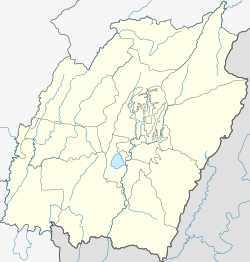Bishnupur Lamangdong | |
|---|---|
Town | |
 Vishnu temple after which Bishnupur is named | |
| Coordinates: 24°38′00″N93°46′00″E / 24.6333°N 93.7667°E | |
| Country | |
| State | Manipur |
| District | Bishnupur |
| Population (2001) | |
• Total | 16,704 |
| Language(s) | |
| • Official | Meiteilon (officially called Manipuri) [1] |
| Time zone | UTC+5:30 (IST) |
| Postal code | 795126 |
| Vehicle registration | MN |
| Website | bishnupur |
Bishnupur is a town in Bishnupur district in the state of Manipur, India. It derived its name from an ancient Vishnu temple located in the town. There is no official record of when exactly the town was named but it is likely during the reign of Bhagyachandra in the mid 18th century. Bishunupur is the administrative headquarters of Bishnupur District.
Contents
- Civic administration
- Demographics
- Economy
- Agriculture
- Tourist attractions
- Loukoipat
- Vishnu Temple
- Politics
- References
In ancient times, Tongjei Maril, lit. 'tubehole') through Bishnupur was the sole road linking Manipur with the rest of India. Bishnupur was one of the sites of the World War II where fierce fightings between the Allied Forces and the Japanese Forces took place. The British war hero, Major-General Orde Wingate, the founder of the Chindits force, died in a plane crash near Bishnupur while flying back from Chindit-held bases in Burma. Many descendants of Japanese armed forces who died here during the War visit Bishnupur to pay homage to their departed ancestors.

